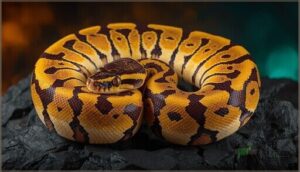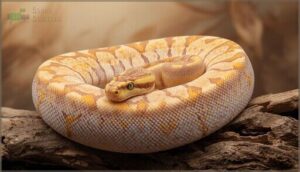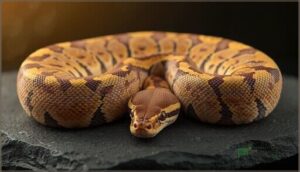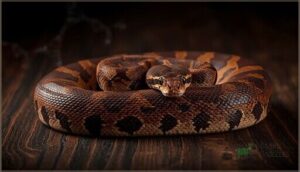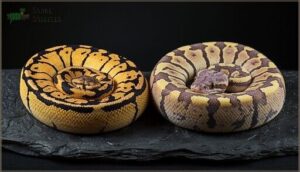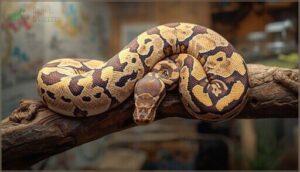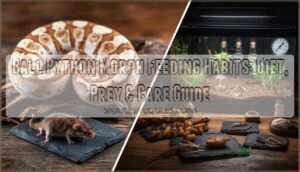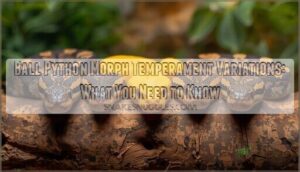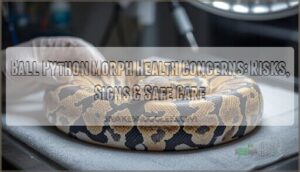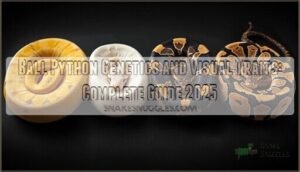This site is supported by our readers. We may earn a commission, at no cost to you, if you purchase through links.

You breed a Pastel ball python with a normal one, and half the clutch glows with butter-yellow intensity while the other half looks exactly like their wild-type parent. That’s co-dominant genetics at work—and it’s the reason ball python co-dominant morph traits have revolutionized reptile breeding.
Unlike recessive genes that hide for generations or simple dominants that overpower everything, co-dominant morphs give you three distinct outcomes: normal, single-gene morph, and the jaw-dropping super form. Understanding how these traits pass from parent to offspring lets you predict exactly what combinations will hatch from your eggs, turning breeding from guesswork into precise genetic artistry.
Table Of Contents
Key Takeaways
- Co-dominant morphs give you three distinct visual outcomes—normal, single-gene morph, and super form—making breeding predictable because you’ll see results in the first generation instead of waiting for hidden recessive genes to show up.
- When you pair two snakes carrying the same co-dominant gene, you get a 25% chance of super forms, 50% single-gene visuals, and 25% normals, but some super forms like Super Cinnamon carry serious health risks including skull deformities and spinal kinks that ethical breeders avoid.
- Stacking multiple co-dominant genes creates exponentially more combinations—three independent genes can produce odds as low as 1 in 32 for specific multi-gene morphs, which is why designer combos command premium prices in today’s saturated market.
- Popular co-dominant morphs like Pastel, Banana, and Enchi work as versatile building blocks because they enhance nearly any pairing, while morphs like Spider and Champagne carry neurological issues that demand transparent health disclosures and careful lineage tracking.
Ball Python Morph Genetics Explained
Before you start mixing morphs and predicting outcomes, you need to understand how ball python genetics actually work. The terms might sound complex at first, but they’re really just labels for how traits get passed from parents to offspring.
Let’s break down the basic concepts that’ll make you confident in reading any breeding chart or predicting what your snakes might produce.
Basic Genetic Terms and Concepts
Understanding ball python genetics starts with a few key building blocks. Each gene sits at a specific locus on a chromosome, and the two versions you inherit—one from each parent—are called alleles. Your snake’s genotype is its genetic blueprint, while the phenotype is what you actually see: color, pattern, and structure. A snake’s genetic makeup determines its physical characteristics.
- Homozygous means two identical alleles at a locus
- Heterozygous means two different alleles at the same spot
- Segregation ensures each parent passes just one allele per trait
These mutation-driven morphs follow predictable inheritance patterns, letting you forecast which co-dominant traits will pop up in your clutch.
Difference Between Dominant, Recessive, and Co-Dominant Traits
Three inheritance patterns shape your breeding outcomes. Dominant genes like Spider or Pinstripe express themselves with just one copy—heterozygous and homozygous animals look identical, so phenotype visibility is immediate but super forms don’t exist.
Recessive genes such as Albino hide until you pair two copies, making inheritance probabilities tricky since hets appear normal.
Co-dominant traits—true incomplete dominance—give you the best of both worlds: single alleles create visible morphs, while homozygous “super forms” deliver breeding implications you can’t get elsewhere.
Many breeders find success by understanding Ball Python genetics.
How Morphs Influence Color and Pattern
Morphs rewire pigment distribution at the genetic level. Melanin reduction genes strip dark saddles down to cream and yellow, boosting pattern contrast you’ll notice right away.
Pigment shifts through MC1R variants swap black for orange or gray, changing morph coloration and patterns without touching scale count.
Codominant traits alter phenotype visibility in single doses, so you’re seeing genetic traits express themselves before breeding age.
Age evolution means hatchling colors won’t match adult phenotype—market selection rewards morphs that hold contrast over time.
What Are Co-Dominant Morph Traits?
Co-dominant traits are the sweet spot of ball python breeding—you get visible results fast, and if you’re lucky enough to pair two copies together, you achieve an even more dramatic “super” form. Think of it like a volume dial: one copy turns up the color and pattern, two copies cranks it all the way to eleven.
Let’s break down how these genes work, what they look like in action, and why breeders can’t get enough of them.
Definition of Co-Dominant (Incomplete Dominant) Traits
In the ball python world, you’ll hear “co-dominant” tossed around constantly—but here’s the genetics secret: we’re really talking about incomplete dominance. This genetic terminology means one copy of the gene tweaks your snake’s phenotype expression visibly, while two copies crank up that effect even more.
Unlike a recessive gene hiding quietly or a purely dominant gene taking full control, codominant traits deliver three distinct looks: normal, single-gene morph, and “super” form.
This morph classification matters hugely for breeding implications—you’re working with a predictable, three-tier system.
Expression in Heterozygous Vs. Homozygous (Super) Forms
When you breed a heterozygous Pastel to a normal, you’ll get roughly 50% visual morphs—that’s basic codominance in action.
But pair two Pastels together, and the genetic states shift dramatically: 25% normals, 50% single-gene Pastels, and 25% Super Pastels. That homozygous super morph shows intensified visual intensity—brighter colors, cleaner patterns—proving phenotype consistency scales with gene dosage, creating huge breeding implications for your projects.
Visual Examples of Co-Dominant Morphs
Picture a Pastel—golden hues splashed over cleaner alien-head markings, faded crown, lighter head, visually graded intensity. Now check Banana: lavender freckling, bright yellow blotches, softer pattern boundaries defining phenotype.
Enchi shows pattern recognition at its finest—connected sides, reduced clutter, enhanced orange tones. Cinnamon? Deep chocolate with reddish chains.
These visual traits reveal codominance in action, guiding morph identification and breeding outcomes through observable coloration shifts.
Notable Co-Dominant Ball Python Morphs
Now that you understand how co-dominant genetics work, let’s look at some of the most popular morphs you’ll encounter in the ball python world. Each one brings its own unique color changes and pattern shifts to the table.
We’ll cover what makes these morphs special and what their super forms look like when you combine two copies of the same gene.
Pastel
Think of Pastel as your gateway to accessing the co-dominant Ball python morphs—it brightens yellows, creates hooked alien-head patterns, and often gifts those stunning green eyes. When you pair two Pastels, you’ll reveal the Super Pastel phenotype with even more intense color and that signature faded head.
It’s perfect for beginner projects, combining easily into designer morphs like Bumblebee while keeping solid market value.
Banana
Banana genetics delivers that jaw-dropping combo of lavender-tan base with bright yellow-orange blotches—plus those signature “freckles” that develop with age. What makes this morph fascinating is its sex-linked traits, where male-maker and female-maker lines skew offspring ratios dramatically. You’ll love combining Banana with darker morphs like Cinnamon for stunning contrast.
Here’s why it’s a breeding favorite:
- Codominant traits create visible phenotypes in single-gene form
- Super Banana shows lighter, pastel-washed coloration
- Visual phenotypes shine in multi-gene designer projects
- Market value stays accessible at $200-700
Currently priced mid-range, Banana offers amazing versatility whether you’re chasing complex combos or building your first breeding project with dominant traits that deliver reliable visual results.
Enchi
Enchi genetics brings warmth to the table—think rich oranges, coppers, and chocolate browns that intensify as your snake matures. This visual phenotype beautifully reduces side patterns, making it perfect for multi-gene combos.
Breeding probabilities follow Mendelian patterns reliably. Pair it with Mojave or Fire for jaw-dropping contrast. Market relevance? Enchi remains a top building-block dominant gene because it enhances nearly everything—no weird health baggage, just consistent genetic traits you can count on. Super Enchi cranks those golden tones even higher, proving genetic inheritance done right delivers impressive ball python morphs every clutch.
| Breeding Pairing | Expected Offspring |
|---|---|
| Enchi × Normal | 50% Enchi, 50% Normal |
| Enchi × Enchi | 25% Super, 50% Enchi, 25% Normal |
| Super Enchi × Normal | 100% Enchi |
| Super Enchi × Enchi | 50% Super, 50% Enchi |
| Super Enchi × Super | 100% Super Enchi |
Cinnamon
Cinnamon genetics showcase one of the earliest dark co-dominant genes from the early 2000s, delivering rich chocolate-brown tones with keyhole patterns—but there’s a catch. Super Cinnamon animals risk serious duckbill deformities and spinal kinking, raising major breeding concerns.
Market impact? Single-gene Cinnamon ball python combos remain popular, yet ethical breeders avoid Cinnamon × Cinnamon pairings. Understanding co-dominant gene inheritance protects your ball python breeding projects and genetic integrity.
Lesser and Butter
Lesser and Butter ball pythons sit at the heart of the BEL Complex, delivering high-yellow visual phenotypes with tan blushing that breeders love. These codominant Ball Python morphs create stunning super forms—blue-eyed leucistic beauties—when paired together or with themselves, driving consistent market demand.
- Lesser reduces dark patterning while intensifying lateral brightness
- Butter ball pythons produce creamier caramel tones with soft contrast
- Breeding outcomes follow simple Mendelian ratios: 25% BEL, 50% visual, 25% normal
Super Forms and Their Characteristics
When you breed two copies of the same co-dominant gene together, you reveal super forms—homozygous phenotypes that crank up color and pattern beyond single-gene animals. Super Pastel ball pythons glow brighter yellow with washed-out heads. Super Banana animals display intense lavender freckling. But not all superforms shine equally—some carry health implications you can’t ignore.
| Super Form | Key Visual Traits |
|---|---|
| Super Pastel | Brighter yellow, faded head, high contrast |
| Super Banana | Lavender coloration, heavy freckling |
| Super Enchi | Pattern reduction, cleaner sides |
| Super Cinnamon | Nearly patternless, dark body, structural risks |
Super Enchi shows dramatic pattern reduction with clean banding. Super Cinnamon, however, is where breeding gets tricky. This homozygous dark morph carries an increased risk of spinal kinks and skull deformities—breeders often avoid Cinnamon × Cinnamon pairings for this reason.
Here’s the breeding math: Pair two heterozygous animals carrying the same dominant gene, and you’ll statistically get 25% super form, 50% single-gene visuals, and 25% normals. Breed a super to a normal? You get 100% visual offspring—no hidden recessive genes lurking.
Market value reflects this genetic power. Super forms command premium prices because they guarantee visual results and deliver more extreme traits. But remember: Visual intensification doesn’t always mean healthier animals. Smart breeders weigh the wow factor against welfare, choosing pairings that produce stunning ball python morphs without compromising genetic health.
Super forms command premium prices and guarantee visual results, but smart breeders prioritize genetic health over extreme traits
Inheritance Patterns of Co-Dominant Morphs
Understanding how co-dominant morphs pass from parents to offspring is like unlocking a genetic treasure map. You’ll need to grasp some basic Mendelian principles and learn how to predict what your baby ball pythons will look like before they even hatch.
Let’s break down the inheritance patterns that make breeding these stunning morphs both predictable and exciting.
Mendelian Principles in Ball Python Breeding
When you understand Mendelian genetics, you’re basically unlocking the breeding code for your ball pythons. Each snake carries two copies of every gene—one from mom, one from dad.
Independent assortment means these genes shuffle separately, letting you predict outcomes using Punnett squares.
Inheritance patterns follow predictable ratios, whether you’re working with dominant, recessive, or co-dominant traits, making genotype probability calculations surprisingly straightforward once you grasp the basics.
Predicting Offspring Phenotypes With Punnett Squares
Punnett squares turn breeding into a science experiment you can run at home. Here’s how phenotype predictions work in practice:
- Single co-dominant × normal yields 50% visual morphs—though your 6-egg clutch might surprise you
- Co-dominant × co-dominant produces 25% supers, 50% single-gene visuals, 25% normals
- Super forms guarantee 100% visual offspring when paired with normals
- Clutch size impacts how closely your results match predictions—smaller clutches mean bigger statistical deviation
- Inheritance patterns become clearer across multiple clutches, not just one
Your Punnett square shows possibilities, but each egg rolls the genetic dice independently.
Co-Dominant Genes in Multi-Gene Combinations
Stacking multiple co-dominant genes transforms your breeding outcomes into a kaleidoscope of possibilities. When you combine three independent genes—say, Pastel, Enchi, and Yellowbelly—each offspring faces separate 50% odds for every trait. That means specific multi-gene morph combinations can hit probabilities as low as 1 in 32.
| Genes Combined | Total Visual Combos | Market Value Impact |
|---|---|---|
| 2 co-dominants | Up to 4 phenotypes | Moderate premium |
| 3 co-dominants | Up to 8 phenotypes | High premium |
| 4+ co-dominants | 16+ phenotypes | Top-tier pricing |
Breeding techniques using super expression guarantee visual locks—every baby inherits that trait—while other genes vary. Phenotype predictions become exponentially complex, but that’s where genetic combinations shine: you’re not just breeding snakes, you’re crafting designer morphs with incomplete dominance stacking color, pattern, and brightness in ways single genes never could.
Breeding Strategies and Genetic Considerations
Breeding co-dominant ball pythons isn’t just about mixing colors—it’s about making smart decisions that benefit both your project and your snakes. You’ll want to choose morphs that align with your goals while keeping genetic health front and center.
Let’s explore how to build a breeding strategy that’s both successful and responsible.
Selecting Co-Dominant Morphs for Breeding Projects
Choosing the right co-dominant morphs is like building a puzzle—you need pieces that fit your vision and your market. Smart base gene selection sets you up for multi-gene projects that actually sell, while careful planning helps you dodge complex allele risks that can muddy your lines.
Your breeding strategies checklist:
- Pick adaptable base genes like Yellow Belly or Pastel that layer well with recessive projects—genetics knowledge here prevents wasted seasons and boosts offspring value
- Avoid stacking too many complex alleles from the same gene family, which creates all-white animals that hide pattern traits and complicate future pairings
- Match your morphs to market demand trends—co-dominant gene inheritance means 50% visual babies when paired to normals, giving you faster returns than pure recessive work
Ethical Breeding and Genetic Health
Integrity in breeding means you don’t just chase wild colors—you safeguard genetic welfare. Responsible breeding puts genetic diversity first, keeping morph-linked health issues at bay and upholding welfare standards. Market ethics demand transparency and lifelong support. Here’s a quick look at ethical practice:
| Genetic Diversity | Welfare Standards |
|---|---|
| Outcrossing lines | Pre-breeding exams |
| Avoid inbreeding | Return agreements |
| Diverse sires | Health disclosures |
Avoiding Genetic Disorders Linked to Morphs
Not every color combo is worth creating—some morphs carry serious genetic disorders. Spider, champagne, and super cinnamon lines show neurological issues, wobble, and spinal kinking.
Ethical breeding demands you track lineage, outcross for genetic diversity, and avoid morph-linked defects. Health monitoring isn’t optional—it protects genetic welfare.
Transparency about health issues keeps breeding ethics strong and your project sustainable.
Market Trends and Popular Co-Dominant Genes
The ball python morphs market shows clear saturation—pastel and enchi top breeding demand charts, but pricing dynamics have shifted dramatically. Dominant gene combos that once fetched thousands now sell for hundreds.
Market saturation pushed breeders toward emerging trends: stacking multiple co-dominant traits instead of single-gene projects. You’ll find recessive gene layering and high-contrast patterns commanding premium prices in today’s competitive genetics landscape.
Frequently Asked Questions (FAQs)
Can co-dominant morphs breed with recessive morphs?
Yes—you can absolutely pair co-dominant morphs with recessive morphs! These genes sit on different loci, so genetic compatibility isn’t an issue. Offspring inherit both traits independently, creating exciting breeding strategies with predictable outcome probabilities.
Do super forms have different care requirements?
Ironically, super forms don’t need special temperatures or humidity—but some demand sharper eyes. Genetic defect monitoring catches cranial kinks, wobbles, and eye anomalies.
Ethical breeding practices prevent morph-linked challenges, ensuring individualized veterinary care when homozygous offspring need it.
Which co-dominant morphs produce the most valuable combinations?
Banana, Mojave, and GHI deliver the highest multi-gene premiums when paired with recessive genes like Clown or Pied.
These incomplete dominant morphs create striking visual impact and command four-figure prices in designer breeding projects.
How do environmental factors affect co-dominant expression?
Temperature effects during incubation can subtly shift phenotype predictions—warmer eggs may show exaggerated blushing or pattern drift.
Humidity impact on shedding, lighting influence on pigmentation, and enclosure design all help genetic expression shine through cleanly.
Conclusion
Here’s what most breeders miss: ball python co-dominant morph traits aren’t just predictable—they’re stackable. You can layer Pastel over Enchi, add Banana to Cinnamon, and watch genetics multiply into endless combinations.
Each pairing becomes a calculated experiment where you control the canvas. Master these inheritance patterns, respect the ethics behind healthy lines, and you’re not just hatching snakes—you’re architecting living art, one clutch at a time. That’s the real power here.
- https://www.worldofballpythons.com/articles/genetics-co-dominant/
- https://royalconstrictordesigns.com/ball-python-genetics
- https://www.youtube.com/watch?v=gl0UYd33yjI
- https://www.reddit.com/r/ballpython/comments/1aungla/incomplete_codominant_morph_the_cryptic_clown/
- https://research.uga.edu/news/crispr-provides-new-understanding-of-reptile-coloration/

